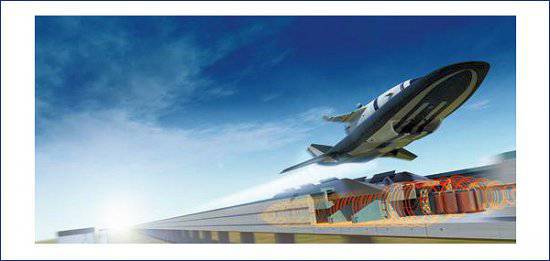NASA presented the project of "shooting" spacecraft
The proposed starting complex is based on the old idea of a railgun (railgun) —a mass accelerator, which is an electrically conductive rails along which the apparatus is guided. The acceleration occurs under the action of a magnetic field excited in the rails.
Used in this case, linear motor power 240 ths. L. with. (almost 180 MW) is capable of accelerating a spacecraft to a speed of 3,2 Mach (1,5 1 km / h) in a plot of 770 km in less than a minute. The overload created in this case does not exceed 3g, which means that the flights will be manned.
In the second stage of acceleration, a hybrid supersonic / hypersonic ramjet engine (ramjet) is activated, thanks to which the device will be able to reach speeds that are 10 times the speed of sound. At an altitude of about 60 km, where there is not enough air to create thrust, ramjet disconnects. The design will allow the engine to self-lower and return to the starting point.
Directly to the orbit of the ship will rocket engines. After completing the mission (for example, delivering the goods), he will be able to return to Earth. After a day you can restart.
The cost of the project is estimated at about $ 1 billion. The cost of each launch will be significantly lower than for shuttles, due to savings on rocket fuel. In addition, such a system allows you to run disparate devices in a short period of time. Finally, it is not so dangerous for astronauts.
Of all the currently existing technologies launching into space without the use of launch vehicles, this is the most developed, says one of the project participants, physicist from the Kennedy Space Center, Stan Starr.
Parts of the system are already being developed: the US Navy is testing a railgun (albeit, as a ship weapons), while Boeing and Pratt & Whitney Rocketdyne are improving ramjet technology on unmanned aerial vehicles (such as the X-51). All the necessary tests can be carried out in the next 10 years, experts say.
At the same time, NASA does not intend to abandon the traditional methods of delivery to orbit. Now the ministry is considering a project to create mini-shuttles, without closing the door to other launch programs with the use of launch vehicles.

Information